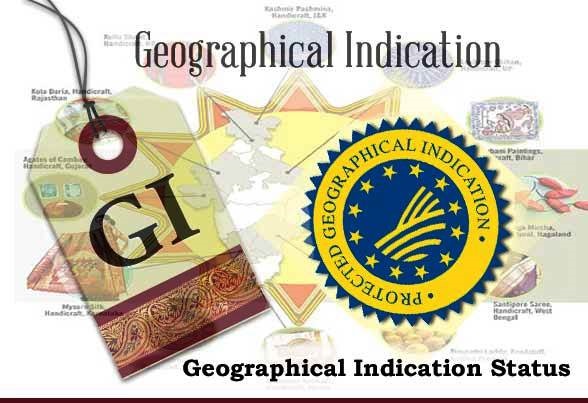PROSPECTS AND CHALLENGES OF GI PROTECTION IN INDIA
Introduction
Geographical indications (GIs) have emerged in the recent past as an important topic of intellectual property rights in the Indian context. Since the introduction of the GI Act on 15 September 2003, more than a hundred Indian items have been registered as GIs. However, when it comes to understanding the potential benefits embedded in GIs, there are many practical challenges facing stakeholders in India.
The GI Act was drafted as part of the country’s exercise to establish national intellectual property laws in compliance with India’s obligations under then Agreement on Trade-Related Aspects of Intellectual Property Rights (TRIPS). The Registry of Geographical Indications was established by the central government of India under the GI Act, which entered into force, together with the GI Rules, with effect from 15 September 2003.
The Controller General of Patents, Designs, and Trade Marks, is the Registrar of Geographic Indications and administers the GI Act. While India has had a significant number of products in its possession that could qualify as GIs, the initiatives to use them began only recently with the enactment of the Geographical Indications of Goods (Registration & Protection) Act 1999 (GI Act), coupled with the Geographical Indication Act 1999 (GI Act). This is how the country developed a sui generis system of GI protection (GI Rules).
Features of Geographical Indication Act 1999
TRIPS do not further explain any of these criteria for “a given quality, reputation and other characteristics.” “The geographical environment, with its inherent natural and human factors” refers to section 11(2)(a) of the GI Act, which stipulates what an application for GI registration should contain. An application for a GI is required, as per section 32(1) of the GI Rules, to be accompanied by “the detailed explanation of the human imagination involved” and “the specifics of special human skills involved”.
As we all know, prima facie registration is proof of legitimacy, the initial registration for GI is for a term of 10 years, which can be extended subsequently. For various classes of products, a single application may be made for the registration of a GI and the fee payable shall be for each class.
The right to a registered GI shall not be the subject of assignment, sale, licensing, promise, mortgage or any other agreement. Generic names shall not be registered under the GI Act and it is important to note that registration of a GI as a trademark is not allowed either.
A licensed GI is protected from violation. The distinction it creates between the two terms is an interesting aspect of the GI Act, ‘registered proprietor’ and ‘authorized user’. In relation to a GI, the “Registered owner” means any group of individuals or producers or any entity as the owner of the GI for the time being entered in the register. Importantly, it is the “authorized users ” and not the ‘registered owner’ who have the exclusive right to use the GI.
This method fits well with the “collective right” essence of GIs, since anyone who can join the trade after registration may also be registered as “authorized users”. However, infringement actions may be taken by both the “licensed proprietor” and the “permitted users”.
Registration Procedure and Current Status of GI In India
The documentation requirements for applying for a GI in India are defined by Section 11(2) of the GI Act. Section 32(1) of the GI Rules replicates these provisions and, in addition, provides for a few additional standards for reporting, including, inter alia, the following: –
- Filing of the Application: Declaration as to the intent of the GI to classify products as originating in the geographical territory concerned with regard to the particular quality, reputation, or other characteristics which are solely or essentially attributable to the geographical environment and its natural and human factors; and the manufacture, processing or preparation of which takes place in the geographical location concerned.
- An affidavit on the applicant’s statement that it represents the interest of an association of persons or producers or of any entity or body founded by or under any law.
- Standards benchmark for the use of the GI or industry standard with regard to the manufacture, exploitation, manufacture, or output of products having a particular quality, reputation, or other characteristics
- Characteristics of such goods, which is basically due to their geographical origin, with a thorough explanation, if any, of the human ingenuity involved or of other characteristics derived from a specific geographical region.
- It shall be examined by the examiners upon receipt of the application and, in the event of any deficiencies, a notice shall be sent to the applicant to rectify them.
- The applicant shall, after rectification, submit their reply in under 1 month of the date of receipt of this letter.
- The next stage is the formation of an advisory committee of professional experts, chaired by the Registrar, to decide if the specifics given in the application are accurate. The range of product categories to which they belong is a striking feature of Indian GIs. These include, among others, textiles, art, paintings, agricultural products, horticultural products and drinks.
Regional Benefits of GI Registration and Its Challenges
Reportedly, about 1,500 Indian products have been listed as having the potential to be registered as GIs. The collective action issues are compounded by some other traditional features of GIs. The process of identifying a GI and codifying the procedures includes the entire supply chain. Therefore, the effective functioning of a GI involves cooperation between all the actors in the supply chain.
Since such a mixture of cooperation and rivalry is a unique feature of GIs, it also further complicates the problem of collective action. These complexities involved in various stages of a GI’s organization and governance typically call for an autonomous and representative body to mediate between the companies.
Challenges:
- Obtaining legal rights made available by these countries is a necessary prerequisite for establishing GI status in foreign countries. However, the procurement of legal armor in various target countries according to their respective legal structures can turn out to be a daunting job.
- When legal rights over a GI are gained, it is important to protect and enforce them. This includes constant market surveillance to decide whether counterfeit products are being passed off. Furthermore, conflicts can occur with rivals as to whether their goods and/or marketing activities are in violation of the GI.
Conclusion
Indeed, the concept of implementing a specific law for GIs was prompted by India’s initiatives to making IPR laws in conjunction with TRIPS in the WTO but was also a need within the region. In view of such a short encounter with the idea of GIs, the steps were taken by stakeholders and various public and quasi-public organizations to ensure the legal security of Indian GIs there under the new legislation are a significant move forward in itself. So far as socio-economics is concerned, it is impossible that the GI registration alone will bring about significant improvements, given the multi-pronged problems facing much Indian GIs, particularly in the handlooms and handloom sectors. At best, the picture that emerges from much farther from different regions of India can be called mixed. Although stakeholders are well aware of the post-registration challenges in cases of a few of the country’s registered GIs and are also taking substantial steps to resolve them effectively.
It must also be emphasized here that, considering the different nature of institutional mechanisms evolving in India for the registration and management of GIs, the readiness and ability of the stakeholders to deal effectively with the multi-pronged complexities are also likely to differ from one case to another in large measures. Hence, the overall commercial, as well as socioeconomic consequences of a GI in India, are also likely to be very much case and context specific.
In order to build its brand image in the global market, India can also cash in on the historical stories, legends, and myths surrounding many of its traditional GIs. India also has a significant ability to grow ” cultural tourism ” around the traditional products by focusing on the national culture associated with them, particularly among foreign tourists. On the one hand, this can provide an opportunity for the country to promote its rural tourism while, on the other hand, simultaneously promoting brand creation, promotion and eventually improving commercial returns from these GIs.




